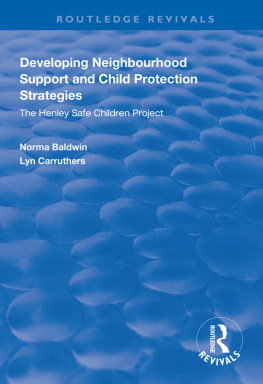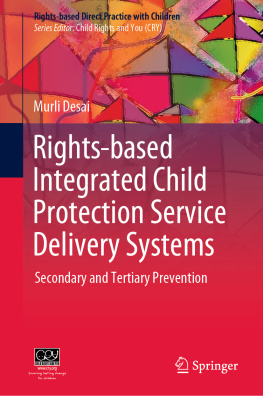DEVELOPING NEIGHBOURHOOD SUPPORT AND CHILD PROTECTION STRATEGIES
First published 1998 by Ashgate Publishing
Reissued 2018 by Routledge
2 Park Square, Milton Park, Abingdon, Oxon, OX14 4RN
711 Third Avenue, New York, NY 10017, USA
Routledge is an imprint of the Taylor & Francis Group, an informa business
Copyright Norma Baldwin and Lyn Carruthers 1998
All rights reserved. No part of this book may be reprinted or reproduced or utilised in any form or by any electronic, mechanical, or other means, now known or hereafter invented, including photocopying and recording, or in any information storage or retrieval system, without permission in writing from the publishers.
Notice:
Product or corporate names may be trademarks or registered trademarks, and are used only for identification and explanation without intent to infringe.
Publishers Note
The publisher has gone to great lengths to ensure the quality of this reprint but points out that some imperfections in the original copies may be apparent.
Disclaimer
The publisher has made every effort to trace copyright holders and welcomes correspondence from those they have been unable to contact.
A Library of Congress record exists under LC control number: 98072850
ISBN 13: 978-1-138-61846-6 (hbk)
ISBN 13: 978-0-429-46120-0 (ebk)
For mothers in the Henley Ward and parents everywhere - who struggle against the odds to give their children a good start in life
We should like to thank the following individuals and agencies for resources, ideas and materials which were helpful in developing the work of the Henley Safe Children Project, the New Links Project and in writing the book.
Parents and workers in the Wood End and Bell Green areas of the Henley Ward. For planning, writing and effective delivery in the dissemination of parents views Elaine OBrien, Nicki Moore, Sam OConnor, Mandy Watson.
Home Office Safer Cities Project in particular Margaret Geary. The NSPCC. Sue Fallon, formerly of the NSPCC.
Coventry City Council and Social Services Department. Allen Torrance and members of the Policy, Research and Planning Sections of Coventry Social Services Department. Workers from the northeast team of the Community Education section for support, access and co-work. Carol Hayden and Sarah Holmes of the Wood End Area Management Team.
Freddie Lewis, Locality Manager, Health Authority. Nick Spencer, University of Warwick.
For census information and statistics the Economic Development Department, Coventry City Council. For help with mapping Kris and Paul Benington. For presentation of maps and figures Gina Finlayson, Town & Regional Planning, University of Dundee.
For endless patience with word processing of drafts, reports and the book Shelley Arthers of the NSPCC, Rhona Goodall and Judy Ahola, University of Dundee.
Responsibility for the material in the final form, for interpretation and opinion, remains with the authors.
A theme of this book is that commitment to promote the wellbeing of children demands a detailed analysis of the range of factors which affect their life chances, at societal, neighbourhood, organisational and interpersonal levels. It demands a style of working which acknowledges this complexity and searches for solutions which reflect it in their objectives, principles and process. Such an approach is longterm, painstaking. It depends on agreed interagency strategies which involve local people in planning, implementation and evaluation.
At the end of the 1980s and beginning of the 1990s, following numerous inquiries into child deaths and serious incidents of child abuse, resources for child care were increasingly directed towards investigations of child abuse. Individual crisis work came to dominate child care services.
This book documents attempts in one area of Coventry to resist pressure to subsume all work with children and families under narrowly conceptualised child protection work. It is concerned with what is needed to support families; why it is needed; how it can best be provided.
The Henley Safe Children Project was set up in response to concerns by social workers, health care professionals, educationalists and social work educators and researchers, that individualised crisis work and child protection investigations were increasingly taking attention and resources away from neighbourhood family support and preventive work. The strong demonstrated links between disadvantage and many aspects of harm to children including abuse, neglect, poor school achievements and crime provided its rationale. The project was based on a commitment to work in partnership with parents, recognising them as experts on their own situations, to explore their views about keeping their children safe and to encourage agencies and individual professionals to give greater priority to family support and preventive work.
Since the Henley Project was set up, there has been a welcome change of emphasis in work with children and families, towards a much closer attention to ways in which families can be supported and harm prevented.
There have been changes in social policy, nationally and locally. A greater willingness to acknowledge the connections between individual needs and experience and wider economic and social factors is now apparent. European emphases on preventing social exclusion support this changing climate.
We hope that our account of experience in trying to work in this way however modest in its scope and achievements will be of benefit to policy makers, managers and social workers as they continue their efforts to develop childrens services plans which will promote wellbeing for all children, refocusing services for the millenium.
A lot of the material in the book comes directly from parents struggling in difficult circumstances to bring up their children in health and safety. Their energy, successes, commitment and wisdom, as well as their failures, can teach us all a great deal
We have the same fears as professionals for our children we also have the same expectations for them as everyone else does. We have found that people do care about children but we need support to carry on caring. We want to help professionals to help us.
We all have a responsibility to make children safe.
From Henley Safe Children Project Summary Report 1993 Keeping children safe: a responsibility for us all.
Since we began talking to policy makers, attitudes about parents living on this estate have changed. Two years ago we were told that it would be impossible to have a safe play area built on the estate. Now the local authority have identified 200,000 to build one in consultation with local parents and children. The local authority have also shown a commitment to providing child care, and to ensure that meetings on service provision are scheduled at times that parents can attend. The NSPCC has responded positively to our views by providing our area with a coordinator and administration time for the New Links Project which is building on the work of the Henley Safe Children Project providing support to local parents, particularly those more likely to be isolated, through a network of trained parent volunteers.
Elaine OBrien, Nicki Moore, Sam OConnor, Mandy Watson Henley Safe Children Project: Letter to NSPCC.
Chapter one sets out the context of child protection and family support. It emphasises the known links between disadvantage, high child protection referrals and a range of harm to children. It describes some preventive schemes which have attempted to take account of these links.











